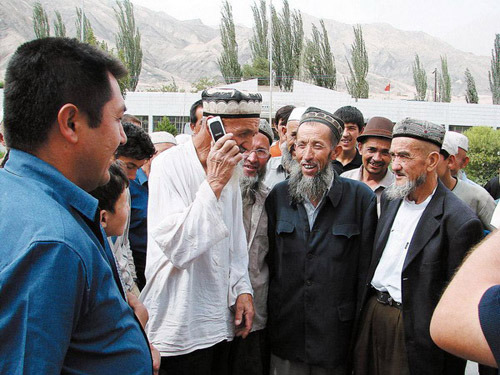
An elderly Uygur villager trying his new cellphone by calling his relatives. Xinjiang Uygur autonomous region is experiencing rapid change thanks to the introduction of mobile technology. China Mobile Ltd, the nation's biggest mobile operator by user base
Residents find their lives far easier thanks to living in a wireless world
Mobile Technology has not only revolutionized communication but has also helped people to lead a more efficient, greener and richer life in Northwest China's Xinjiang Uygur autonomous region.
Xinjiang, which occupies one sixth of China's territory, has a population of 22 million, of which more than 64 percent belong to non-Han ethnic groups. Although the region is rich in natural resources, has vast areas devoted to pasture and produces premium fruits, Xinjiang's economy is still lagging far behind those of many other provinces and regions, especially ones in China's coastal areas.
However, the autonomous region is experiencing rapid change thanks to the introduction of mobile technology. China Mobile Ltd, the nation's biggest mobile operator by user base, has made a total investment of 30 billion yuan ($4.72 billion) in Xinjiang since 1999. The number of China Mobile's customers in Xinjiang reached 12.7 million by 2011, up almost 50 times over the past decade.
Tens of thousands of mobile signal transmission towers have sprung up in Xinjiang, connecting people and helping the region get more closely involved in China's dynamic economic activities.
Wireless City
Karamay, an important oil industry hub in Junggar Basin, northern Xinjiang, was a barren land that supported very few creatures half a century ago. As more outside workers thronged to the city to explore the rich oil resources and creating an economic boom, Karamay developed into a modern and pleasant place and became the first wireless communications city in China's northwest regions.
The Wireless City project, which has been promoted by China Mobile since 2008, aims to provide the public with information and services on mobile terminals. It also aims to help improve the management of local government.
Walking the streets of Karamay today means walking amid an unseen web of 2G, 3G and Wi-Fi networks. Local residents can log on to the Wireless City website to enjoy nearly 50 types of urban information services covering government affairs, public utilities and personal life.
The mobile applications, which appear on the Wireless City portal wap.xjwxcs.com, provide all kinds of information an individual needs for everyday life, including real-time transport updates, shopping details, online restaurant reservations and payments for public utility bills.
"They (Wireless City applications) are very useful. First of all, I don't have to stand in the freezing weather for hours to wait for a bus now," said Wang Hu, a State-owned company worker in Karamay. In winter, when the temperature drops to -20 C, Wang searched for the specific bus he was about to ride on a mobile application.
He can find out immediately when the bus is due and leave home in time to meet it.
In Karamay, almost every bus station has an electronic screen telling people when buses are due to arrive. To enable this, the local government established a smart transportation system that embeds both a global positioning system and wireless technology. It is able to monitor public transportation, manage or dispatch taxis and release real-time information on the Wireless City website.
"The government built the system and offers the content. The content flows through the Wireless City portal and is available on people's mobile phones," said Wang Xiaokang, deputy manager of the group client department at China Mobile Karamay branch. This transportation service has greatly relieved traffic jams in the city and helped save people's time, he added.
Teachers can send messages from schools to parents via a mobile application, informing them how their children are behaving on campus and parents can respond immediately. Students have no need for cards at school because the mobile phone can help them complete various tasks, including buying meals and borrowing books. All it takes is a simple swipe of a mobile phone.

Copyright ©1999-2011 Chinanews.com. All rights reserved.
Reproduction in whole or in part without permission is prohibited.